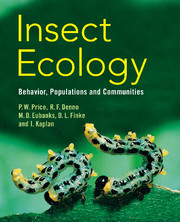Book contents
- Frontmatter
- Contents
- Preface
- Acknowledgments
- Part I Introduction
- 1 The scope of insect ecology
- Part II Behavioral ecology
- Part III Species interactions
- Part IV Population ecology
- Part V Food webs and communities
- Part VI Broad patterns in nature
- Glossary
- References
- Author Index
- Taxonomic Index
- Subject Index
- Plate section
- References
1 - The scope of insect ecology
from Part I - Introduction
Published online by Cambridge University Press: 05 June 2012
- Frontmatter
- Contents
- Preface
- Acknowledgments
- Part I Introduction
- 1 The scope of insect ecology
- Part II Behavioral ecology
- Part III Species interactions
- Part IV Population ecology
- Part V Food webs and communities
- Part VI Broad patterns in nature
- Glossary
- References
- Author Index
- Taxonomic Index
- Subject Index
- Plate section
- References
Summary
Everybody is conscious of insects, and even concerned about them. In fact, we each have an ecological relationship with their kind. We share our houses and gardens with them, our walks and picnics, and our adventures. So should we not understand them? Their richness in species and interactions, their beauty and behavioral intricacy, all enrich our lives if we understand who they are, and what they are doing. Therefore, the ecology of insects is for everybody.
Eisner (2003, p. 1), in his latest book, For Love of Insects, starts by writing that “This book is about the thrill of discovery.” And, Wilson (1994, p. 191), in his autobiographical, Naturalist, advised, “Love the organisms for themselves first, then strain for general explanations, and, with good fortune, discoveries will follow. If they don't, the love and the pleasure will have been enough.” Here is sound advice from two of the greatest practitioners of entomology and ecology, for discovery is thrilling, and the deeper the fascination one develops, the greater will be the discoveries that follow.
- Type
- Chapter
- Information
- Insect EcologyBehavior, Populations and Communities, pp. 3 - 24Publisher: Cambridge University PressPrint publication year: 2011

